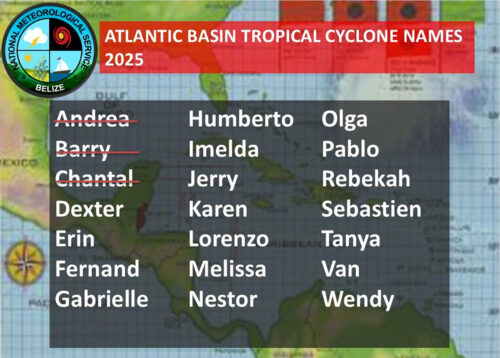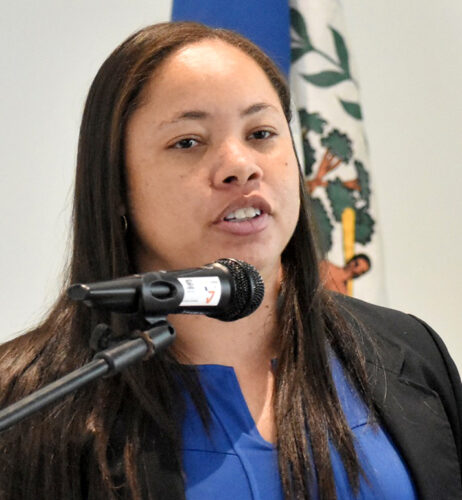Chief meteorologist, Ronald Gordon
by William Ysaguirre (Freelance Writer)
BELIZE CITY, Mon. July 14, 2025
Unpredictable as the weather may be, climatologists, meteorologists, hydrologists and national emergency first responders have evaluated the prospective weather scenarios and calculated the probable risks of climate hazards for the remainder of the year, which they shared when the National Meteorological Service hosted a national climate outlook forum at the Grand Resort in Belize City last Friday, July 11.
The Atlantic Hurricane Season began on June 1, so we are very much concerned about the possibility of a hurricane making landfall in Belize, as hurricanes draw their energy from the sea, and there have been slightly warmer than average sea surface temperatures in the Caribbean and Atlantic, explained chief meteorologist Ronald Gordon. With warmer seas sending billions of megajoules of energy into the atmosphere, we must also consider the likelihood of other factors influencing the formation of hurricanes, such as the “la Niña” phenomenon, which makes for a more active hurricane season, while the “el Niño” phenomenon diminishes the chance of hurricane formation in the Atlantic basin.

With all factors affecting this hurricane season being taken into consideration, the experts currently believe that conditions are likely to be neutral this year, which would suggest that the season will be just slightly above normal. Belize had a warmer than normal dry season in May, and yet the north – Corozal and Orange Walk, experienced unprecedented heavy rainfall last month.
The latest technology and satellite imagery have helped meteorologists make more accurate forecasts over the past 20 years, with up to 3 days’ warning about the occurrence and trajectory of storms, so Gordon recommends that the public pay attention and take heed only of the flood and storm warnings put out by the official agencies. Notably, last year only 2 named storms affected Belize – Nadine and Sara, and the impact was mostly excessive rains and flooding. Hurricane Beryl looked threatening, and NEMO erred on the side of caution when it issued a storm watch warning; but Belize was spared any ill effects. The National Hurricane Center of the National Oceanic and Aeronautic Administration (NOAA) in Miami is predicting 13-19 named storms for this season, of which 6 to 10 may become hurricanes, and only 3- 5 might develop into major hurricanes.
This, however, does not mean that any of these hurricanes will make landfall in Belize, as we were spared last year. Based on past experience, there is a 50 percent chance that a named storm may track near Belize, a 24 percent chance that a hurricane may come close to Belize, and only an 8 percent chance that a major hurricane may come within 50 miles of Belize.

Daniel Mendez, NEMO coordinator
With four of Belize’s urban centers located along the coast, and 3 other district towns built along rivers, it is important to understand our vulnerability and exposure to climate hazards, such as storm surge and river flooding, emphasized Daniel Mendez, coordinator of the National Emergency Management Organization (NEMO). A climate hazard need not become a disaster. Being aware of a hazard can help members of the community to reduce the risk and to cope with the effects when there is a weather event; and having advance warning can reduce the impact by 30 percent, as people evacuate homes and move other assets to minimize exposure to damage.
Hurricanes are not the only climate-related hazard which can have a disastrous impact on Belizean communities. The Ministry of Disaster Risk Management implemented the $2 million “Multi-Hazard Impact-Based Forecasting and Early Warning System for the Belize Watershed Project” in partnership with the Ministry of Economic Development. The project has water level monitoring stations in 8 communities along the river to give residents of communities along the river an early warning of floods or any other hazard, as drought can be almost as destructive due to its impact on crops.

Climate risk specialist Diego Pons – World Food Programme
It is important for Belize to have a multi-hazard warning system, as warmer temperatures, longer dry seasons with less rain, and warmer seas are affecting food productivity for both farmers and fishermen, explained climate risk specialist Diego Pons, PhD, of the World Food Programme. Climate data, monitoring rainfall, atmospheric temperatures and river water levels can help give early warning of when unusually warm atmospheric temperatures may pose a hazard to agriculture and human health.
Knowledge is power, and advance warning of future drought can help farmers adapt by planting drought-resistant varieties of crops, and implementing irrigation systems and other climate-friendly practices to ensure a good yield. Warmer temperatures also give rise to new agricultural pests and diseases, for which farmers need advance warning to prepare measures, such as crop spraying to mitigate these effects, which could otherwise lead to a food crisis when crops fail. Knowing the risk in advance helps reduce and minimize the damage.
Most important is a public information and warning system to get the word out to farmers and other interested parties, so they have time to adapt, with financing to buy new seed, irrigation systems, crop sprayers, and to ensure proper food storage for whatever food crop they are able to produce successfully. This is the key to food security, to mitigate the risk.

Shanea Young, senior climatologist
High atmospheric temperatures may produce heat stress for humans, crops, and livestock alike on land, but warmer seas also affect fishermen, as fish migrate to cooler waters, resulting in less fish caught at traditional fishing grounds, warned senior climatologist Shanea Young. Wildlife – fish, birds and land-based animals—always follow the food, so warmer seas can cause coral polyps to die, seen as “coral bleaching” on the reef, which results in less food for reef fish, and a smaller fish population for fishermen to harvest.
The economic impacts of this climate variation affects human health through heat stress, but also affects other industries such as tourism, energy production and water supply. Tourism operators will have higher energy costs, as visitors’ demand for air conditioning increases electricity consumption, while coral bleaching will impact arrivals of visitors in search of diving adventures to witness the colorful undersea beauty of the reef, and water consumption will increase, even as the water supply diminishes with less rain and water quality in the reservoirs dwindles because of algal blooms. Additionally, reduced levels in reservoirs could diminish energy production from hydro-electric sources, exacerbating the crisis when heat stress increases the demand for cooling systems.

